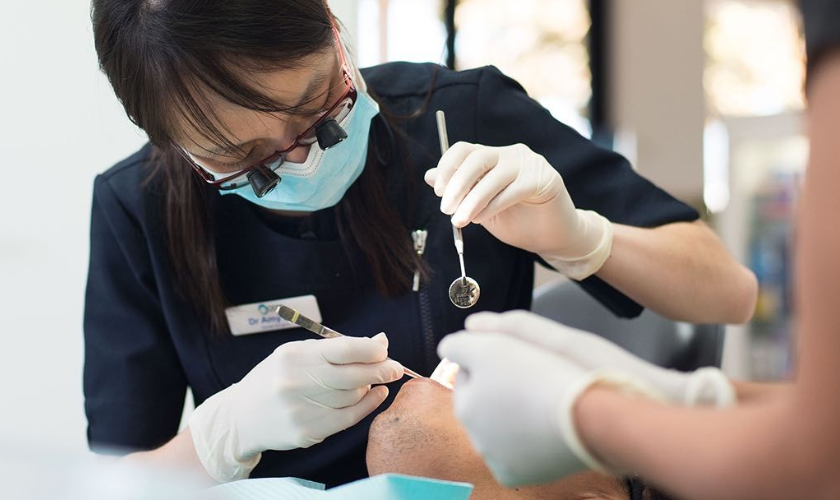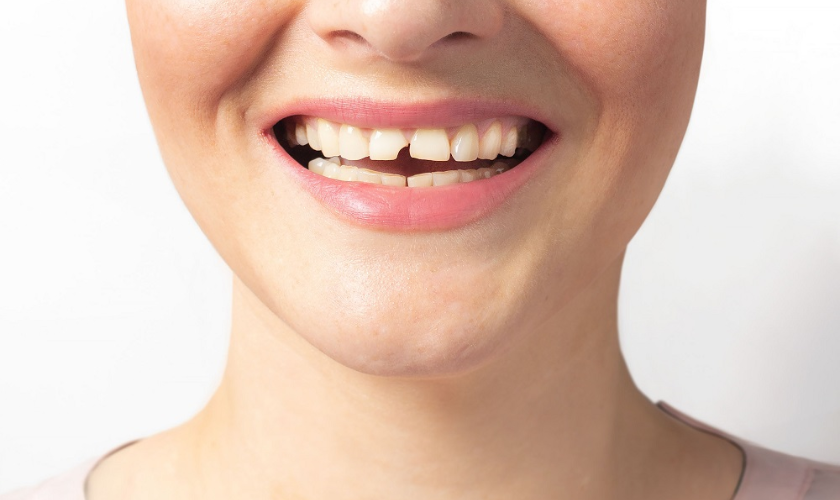
A broken tooth can be a stressful experience, bringing both physical discomfort and worry. Whether it’s a sharp chip, a jagged crack, or a complete loss, a damaged tooth requires prompt attention from a dental professional. This blog will guide you through the essential steps to take until you can see a dentist.
Understanding the Damage: Different Types of Broken Teeth
- Chipped Tooth: This is a minor break that only affects a small part of the enamel, the hard outer layer of the tooth. While not usually painful, it can be aesthetically concerning and might become sensitive to hot or cold.
- Cracked Tooth: This extends deeper than a chip, potentially reaching the dentin layer beneath the enamel. Cracked teeth can cause sharp pain, especially when chewing, and are more susceptible to infection.
- Knocked-Out Tooth: This is the most severe case, where the entire tooth is dislodged from its socket. Time is critical in saving a knocked-out tooth, as the longer it’s out of the mouth, the lower the chance of successful replantation.
Taking Action: What to Do Until You See a Dentist
1. Address Immediate Concerns:
- Pain management: Acetaminophen and ibuprofen, two over-the-counter pain medications, can aid with discomfort management. Aspirin should not be taken as it can worsen bleeding.
- Bleeding Control: If there’s bleeding, apply gentle pressure with a clean gauze pad to the affected area for a few minutes.
- Facial Swelling: Reduce swelling by applying a cold compress to your cheek near the broken tooth. Wrap the compress in a thin cloth to avoid direct contact with the skin.
2. Locate Any Broken Pieces:
- Chipped or Cracked Tooth: If you find a piece of the broken tooth, keep it safe in a container with milk or saliva. This can help preserve the tooth fragment for potential use by the dentist.
- Knocked-Out Tooth: Locate the tooth and handle it carefully. Do not scrub or clean it with harsh chemicals. If possible, gently try to reinsert the tooth back into its socket. Make sure it’s facing the right direction and fits comfortably. If re-implantation isn’t possible, store the tooth in milk, saline solution, or even your saliva. Time is crucial – ideally, you should see a dentist within 60 minutes for the best chance of saving the tooth.
3. Schedule a Dental Appointment Immediately:
- Finding a Dentist Quickly: In a dental emergency, prioritize seeing a dentist as soon as possible. Contact your regular dentist’s office to see if they can accommodate an emergency appointment. If unavailable, consider contacting emergency dental clinics or nearby dental schools that might offer urgent care services. For residents of Baymeadows, [dentist in Baymeadows] might be a good option to explore.
4. Post-Care Measures Until Your Appointment:
- Protect the Broken Tooth: Avoid chewing on the affected side of your mouth to prevent further damage. Stick to soft foods and avoid hot, cold, or sticky foods that can irritate the area.
- Maintain Oral Hygiene: Continue brushing and flossing gently, but avoid the immediate area of the cracked tooth.
Seeking Professional Help: The Dentist’s Role
A dentist will thoroughly examine your broken tooth, assess the extent of the damage, and recommend the most appropriate treatment course. Depending on the severity of the break, treatment options might include:
- Bonding or Resins: For minor chips, a dentist can use tooth-colored bonding material to restore the tooth’s shape and appearance.
- Fillings: For deeper cracks or fractures, a filling material might be used to repair the damaged tooth structure.
- Crowns: In cases of significant damage or cracks that reach the pulp, a crown (a cap placed over the tooth) might be necessary to restore strength and functionality.
- Root Canals: If the pulp (the inner chamber containing nerves and blood vessels) becomes infected due to the break, a root canal treatment might be needed to remove the infected tissue and save the tooth.
- Extractions: In severe cases where the tooth is too damaged or the root is fractured, an extraction might be the only option.
Preventing Broken Teeth: Proactive Steps
While accidents can happen, here are some ways to minimize the risk of breaking a tooth:
- Maintain good oral hygiene: Regular brushing and flossing remove plaque and bacteria, keeping teeth strong and healthy.
- Schedule regular dental checkups: These allow dentists to identify and address potential problems early on before they escalate.
Living with a Broken Tooth Until Dentist: Additional Tips and Considerations
While the above steps provide a roadmap for the immediate aftermath of a cracked tooth, here are some additional points to consider as you navigate this situation:
Diet:
- Soft Food is Key: Stick to soft, easily chewable foods like mashed potatoes, yogurt, applesauce, soups, and steamed vegetables. This minimizes pressure on the broken tooth and helps prevent further damage.
- Avoid Irritants: Steer clear of foods that are extremely hot, cold, sticky, or hard. These can irritate the sensitive area and potentially worsen the discomfort.
- Chewing Technique: It’s best to avoid chewing on the side of your mouth with the cracked tooth altogether. If you must chew on that side, do so very cautiously.
Pain Management:
- Over-the-counter Medications: As mentioned earlier, over-the-counter pain relievers like acetaminophen or ibuprofen can help manage discomfort. Always follow the recommended dosage instructions.
- Dental Anesthetics: For severe pain, a topical dental anesthetic gel might offer temporary relief. These are typically available over-the-counter at most pharmacies. Consult the pharmacist for guidance on appropriate use.
- Natural Remedies: Some people find relief with natural remedies like applying a cold compress or a warm saltwater rinse to the affected area.
Oral Hygiene:
- Brushing and Flossing: Continue your regular oral hygiene routine as much as possible. However, be gentle around the broken tooth to avoid causing further irritation. Consider using a soft-bristled toothbrush for added comfort.
- Rinsing with Caution: Warm salt rinses can help soothe the area and reduce inflammation. However, avoid using mouthwash containing alcohol, as it can cause stinging and dryness.
Emotional Impact:
A cracked tooth can be a stressful experience, especially if it affects your smile or ability to speak. Don’t hesitate to reach out to a trusted friend, family member, or therapist for support if needed.
Financial Considerations:
Dental emergencies can be costly. If you have dental insurance, contact your provider to understand your coverage for broken teeth and emergency procedures. Consider exploring payment plans offered by some dental practices if needed.
A broken tooth can be disruptive, but by following these steps and seeking professional help promptly, you can minimize discomfort, prevent complications, and get your smile back on track. Remember, the sooner you see a dentist, the better the chances of successful treatment and tooth preservation.



